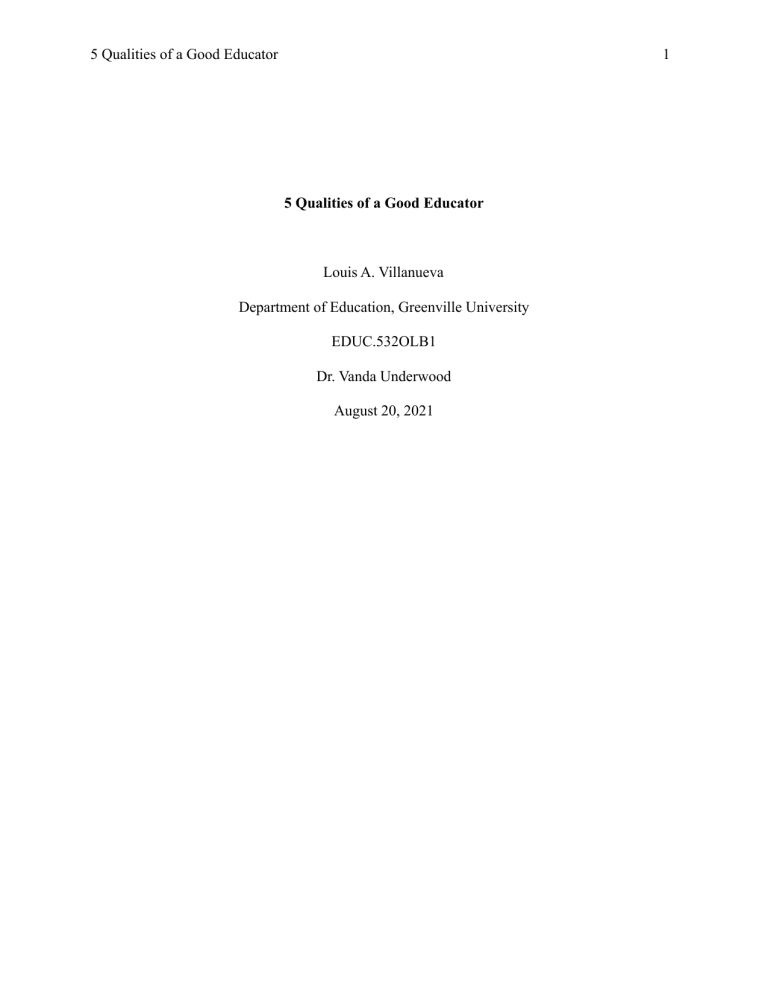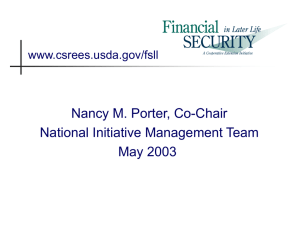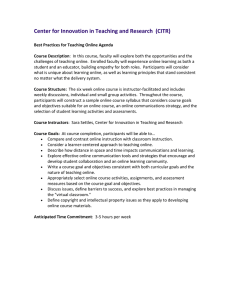
5 Qualities of a Good Educator 1 5 Qualities of a Good Educator Louis A. Villanueva Department of Education, Greenville University EDUC.532OLB1 Dr. Vanda Underwood August 20, 2021 5 Qualities of a Good Educator 2 5 Qualities Of A Good Educator Creating a positive environment for students is above all the most important attribute that every educator should strive to utilize. There is a certain amount of responsibility that teachers must adhere to, responsibilities that stretch far beyond the classroom and the paperwork. There is an emotional and empathetic duty that educators need to cling to in order to help our students grow as learners and as human beings. This paper will characterize the 5 characteristics that an educator must possess in order to be considered a great educator. Empathy, communication skills, inclusivity, knowledge of technology and of conflict resolution are the 5 characteristics that each educator should at least try to acquire in their professional journeys. With these tools, any teacher can give any student the feeling of a comfortable learning environment where they can grow and succeed as students in our modern education system. As all of these qualities are of great importance, this paper will categorize these qualities in order from greatest of importance to least. Empathy Austrian psychologist Alfred Adler states “Empathy is seeing with the eyes of another, listening with the ears of another and feeling with the heart of another.” Everyday, teachers come across children that have led or are leading different lives than themselves. Teachers should have the ability to recognize the differences within their students but also treat them with respect, empathy and remain objective in how they treat their students. The authors describe this as “feeling with,” wherein one does not feel for or act on behalf of an individual; rather, one is with the individual in a nonjudgmental fashion. This type of empathy has also been referred to as altruism. (McAllister & Irvine, 2002) Giving the student the opportunity to feel accepted, even in times 5 Qualities of a Good Educator 3 where they may have done something wrong, teaches empathy. These actions can also create a more solid bond between the student and the teacher. Some research suggests that employees with an awareness of Emotional Intelligence will perform better at their jobs. In the Journal of Organizational Behavior, Ernest O’Boyle, Jr. states “Recent research highlights the importance of Emotional Intelligence as a predictor in important domains such as academic performance, job performance, negotiation, leadership, emotional labor, trust, work-family conflict and stress”. (O’Boyle, 2011, p. 789) Emotional intelligence and altruism can all be factored in with empathy as necessary qualities of a good educator. Communication Communication skills should be recognized as an important characteristic of an educator. Knowing your audience is a big step to understand how to approach a situation. Maybe sometimes punishing tones of voice, anger or penalizing techniques are not the route a teacher should take. There is a counterproductive role that power and punishment currently play in schools, this treatise challenges educators to inspire cooperation without using demands, strengthening student interest and classroom community from within. If we ask two questions of ourselves, we will see that punishment never works. 1) What do we want the other person to do? 2) What do we want the other person’s reasons to be for doing as we request? Now for most people raised in our culture, they can’t imagine what a world would look like without punishment...It’s a hard concept to let go of until you really get clear about those two questions. If you don’t get clear about those two questions, you can often end up thinking punishment works when it really doesn’t. (Rosenburg, 2004, p. 12-14) 5 Qualities of a Good Educator 4 There is not any lesson learned if the only reason for doing something is out of fear of punishment instead of inherent practicality of doing the act in the first place. Emotional support through communication is also important for the teacher and student relationship. There is a feeling of improved mental health when communication between two people is designed to help instead of criticize. It seems obvious that the formation of personal, supportive teacher–student relationships inherently demands emotional involvement from teachers. For students, it is evident that the effective quality of the teacher–student relationship is an important factor in their school engagement, wellbeing, and academic success. (Split, Kooman & Thijs, 2011) A good educator can open up the highways of communication with students and colleagues alike and increase the level of engagement and comfortability within the culture of their classroom. Inclusivity In order to create an authentic cultural dialogue in the high school setting, parents need to accept that children’s books do not always give an accurate representation of each culture. It is the duty of the educator to recognize and counter this issue within their classrooms. This awareness of inclusivity must be a part of the list of qualities for a good educator because denying the struggle of inclusivity is denying the emotions of one hundred percent of your student body. “Children’s literature is profoundly influential in the lives of students and is widespread throughout schools, libraries, and homes. However, the field of children’s literature lacks diversity across several domains, particularly race, gender, and ability. Educators must be knowledgeable on how to use diverse children’s literature as a tool to teach about diversity, as they strive to foster inclusive classroom environments.” (Leahy & Foley, 2018) According to the 5 Qualities of a Good Educator 5 book Multicultural Education of Children and Adolescents, the author has based the concept of multicultural education on the premise that people from culturally different backgrounds enrich the United States and that a better understanding of people and their differences leads to higher levels of acceptance and respect for all people. (Manning, 2017) At the end of the day, inclusivity perpetuates respect amongst all individuals. This is a concept that educators need to address early on in a child’s career as a student. Knowledge of Technology Technology is important in the classrooms for many reasons. In particular, it supplements lessons with more material for a healthier understanding of the content. It also prepares students for their futures in the job market as well as builds self esteem in the classroom. In the Journal of Marketing Education, the author states that students have a tendency to be more open and confident when engaging online or through mobile technology. Teachers that can utilize the use of technology, either with a computer or mobile devices, will tend to have students that are more capable of opening up to rhetoric and lessons. (Florenthal, 2019) In a world where technology sits at the forefront of all or even most money making positions, students should begin as children to understand the dynamic and strategy that technology can offer. The educator should have all of the potential abilities to transcend this knowledge in the classroom and to their students. (a) strong school support, (b) robust technology infrastructure, (c) sustained professional development opportunities, (d) positive teacher attitude toward technology, and (e) ample personal use of technology. We theorize that these five conditions allow teachers to create sustainable digital ecosystems that will support technology integration into the gifted education classroom. (Besnoy, Dantzler & Siders, 2012) 5 Qualities of a Good Educator 6 This is an opportunity for the teacher to give his students the “real world” skills and tools that exist outside of their regular content. Conflict Resolution According to David Johnson and Roger Johnson, if an educator can focus on confuciun philosophy of meditation and moral persuasion, he or she can deescalate intense or pre-violent situations. They also explain a program they created in the nineties called the Peacemakers. With this program they would offer conflict resolution trainging for other students to help with, well, other students. (Johnson & Johnson, 1995) Management of the classroom is the first effective quality to maintain conflict resolution in the classroom. Setting boundaries and being consistent will give the teacher a better chance at bringing down the intensity of a conflict if they arise. “High dominance is characterized by clarity of purpose and strong guidance. The purpose and guidance provided by the teacher should be both academic and behavioral—that is, the teacher provides purpose and guidance relative to the content addressed in class as well as the behavior expected in class.” High dominance and high cooperation is the key. (Marzano & Gaddy, 2005, p. 41-44) To conclude, these are the highly valuable characteristics of an effective teacher, a good educator. Empathy and understanding should be thought of in any line of work or any type of relationship, either professional or personal. Guiding students toward this understanding is tantamount to building, not only a better classroom, but also a better society. 5 Qualities of a Good Educator 7 References: Besnoy, Kevin D, John A Dantzler, and James A Siders. “Creating a Digital Ecosystem for the Gifted Education Classroom.” Journal of Advanced Academics 23.4 (2012): 305–325. Web. David Johnson, & Roger Johnson. (1995). Reducing School Violence Through Conflict Resolution. ASCD. Florenthal, Bela. “Students’ Motivation to Participate via Mobile Technology in the Classroom: A Uses and Gratifications Approach.” Journal of Marketing Education 41.3 (2019): 234–253. Web. Leahy, M. A., & Foley, B. C. (2018). Diversity in Children’s Literature. World Journal of Educational Research, 5(2), 172. https://doi.org/10.22158/wjer.v5n2p172 Manning, M. Lee. “Multicultural Education.” Middle school Journal 21.1 (1989): 14–16. Web. McAllister, G., & Irvine, J. J. (2002). The Role of Empathy in Teaching Culturally Diverse Students: A Qualitative Study of Teachers’ Beliefs. Journal of Teacher Education, 53(5), 433–443. https://doi.org/10.1177/002248702237397 O’Boyle Jr, Ernest H et al. “The Relation Between Emotional Intelligence and Job Performance: A Meta-Analysis.” Journal of Organizational Behavior 32.5 (2011): 788–818. Web. Robert J. Marzano, & Barbara B. Gaddy. (2005). A Handbook for Classroom Management That Works. ASCD. Rosenberg, Marshall B. Teaching Children Compassionately How Students and Teachers Can Succeed with Mutual Understanding . Encinitas, Calif: PuddleDancer Press, 2004. Print. 5 Qualities of a Good Educator Spilt, J. L., Koomen, H. M. Y., & Thijs, J. T. (2011). Teacher Wellbeing: The Importance of Teacher–Student Relationships. Educational Psychology Review, 23(4), 457–477. https://doi.org/10.1007/s10648-011-9170-y 8





